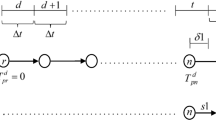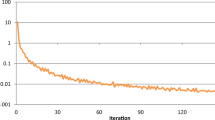Abstract
Network user equilibrium or user optimum is an ideal state that can hardly be achieved in real traffic. More often than not, every day traffic tends to be in disequilibrium rather than equilibrium, thanks to uncertainties in demand and supply of the network. In this paper we propose a hybrid route choice model for studying non-equilibrium traffic. It combines pre-trip route choice and en-route route choice to solve dynamic traffic assignment (DTA) in large-scale networks. Travelers are divided into two groups, habitual travelers and adaptive travelers. Habitual travelers strictly follow their pre-trip routes which can be generated in the way that major links, such as freeways or major arterial streets, are favored over minor links, while taking into account historical traffic information. Adaptive travelers are responsive to real-time information and willing to explore new routes from time to time. We apply the hybrid route choice model in a synthetic medium-scale network and a large-scale real network to assess its effect on the flow patterns and network performances, and compare them with those obtained from Predictive User Equilibrium (PUE) DTA. The results show that PUE-DTA usually produces considerably less congestion and less frequent queue spillback than the hybrid route choice model. The ratio between habitual and adaptive travelers is crucial in determining realistic flow and queuing patterns. Consistent with previous studies, we found that, in non-PUE DTA, supplying a medium sized group (usually less than 50%) of travelers real-time information is more beneficial to network performance than supplying the majority of travelers with real-time information. Finally, some suggestions are given on how to calibrate the hybrid route choice model in practice to produce realistic results.



Similar content being viewed by others
Notes
Total delay equals the total vehicle-hour-traveled (VHT), subtracted by the total free-flow travel time of all vehicle trips taking the same routes as where VHT is computed.
We do not include the results from PUE because a gridlock occurs during the iterative procedure of DNL, and solving the issue of gridlock in the DTA algorithm is beyond the scope of the paper.
References
Bell MGH, Shield CM, Busch F, Kruse G (1997) A stochastic user equilibrium path flow estimator. Transp Res, Part C Emerg Technol 5(3–4):197–210
Bovy P, Stern E (1990) Wayfinding in transport networks. Kluwer Academic Publishers
Bovy PH, Fiorenzo-Catalano S (2007) Stochastic route choice set generation: behavioral and probabilistic foundations. Transportmetrica 3(3):173–189
Carey M, Ge YE (2011) Comparison of methods for path flow reassignment for dynamic user equilibrium. Netw Spat Econ. doi:10.1007/s11067-011-9159-6
Cascetta E, Nuzzolo A, Russo F, Vitetta A (1996) A modified logit route choice model overcoming path overlapping problems: specification and some calibration results for interurban networks. In: Proceedings from the thirteenth international symposium on transportation and traffic theory
Daganzo C (1998) Queue spillovers in transportation networks with a route choice. Transp Sci 32(1):3–11
Daganzo CF (1994) The cell transmission model: a dynamic representation of highway traffic consistent with the hydrodynamic theory. Transp Res, Part B 28:269–287
Daganzo CF (1995) The cell transmission model, part II: network traffic. Transp Res, Part B 29:79–93
Dia H, Harney D, Boyle A (2001) Dynamics of drivers’ route choice decisions under advanced traveler information systems. Roads and Transp Res 10:2–12
Friesz TL, Bernstein D, Smith TE, Tobin RL, Wei BW (1993) A variational inequality formulation of the dynamic network equilibrium problem. Oper Res 41:179–191
Gao S, Frejinger E, Ben-Akiva M (2011) Cognitive cost in route choice with real-time information: an exploratory analysis. Transp Res, Part A Policy Pract 45(9):916–926
Ghali M (1995) A note on the minimum instantaneous cost path of the dynamic traffic assignment problem. Ann Oper Res 60:115–120
Hawas YE (2004) Development and calibration of route choice utility models: neuro-fuzzy approach. J Transp Eng 130(2):171–182
Jin W, Zhang HM (2003) On the distribution schemes for determining flows through a merge. Transp Res, Part B 37:521–540
Jin W, Zhang HM (2004) Multicommodity kinematic wave simulation model for network traffic flow. Transp Res Rec 1883:59–67
Kant P (2008) Route choice modelling in dynamic traffic assignment. Master thesis, University of Twente. http://essay.utwente.nl/58303/
Kuwahara M, Akamatsu T (2001) Dynamic user optimal assignment with physical queues for many-to-many od pattern. Transp Res, Part B 35:461–479
Lebacque J (1996) The godunov scheme and what it means for first order traffic flow models. In: Procedings of international symposium of transport and traffic theory, pp 79–102
Lee C, Ran B, Yang F, Loh WY (2010) A hybrid tree approach to modeling alternate route choice behavior with online information. J of Intell Transp Sys: Technology, Planning, and Operations 14(4):209–219
Lighthill MJ, Whitham GB (1955) On kinematic waves. ii. a theory of traffic flow on long crowded roads. Proc Royal Soc 229:317–345
Mahmassani HS, Jayakrishnan R (1991) System performance and user response under real-time information in a congested traffic corridor. Transp Res, Part A 25(5):293–307
Mahmassani HS, Liu YH (1999) Dynamics of commuting decision behaviour under advanced traveller information systems. Transp Res, Part C 7(2–3):91–107
Merchant D, Nemhauser G (1978) A model and an algorithm for the dynamic traffic assignment problem. Transp Sci 12:183–199
Nie X, Zhang HM (2005) A comparative study of some macroscopic link models used in dynamic traffic assignment. Netw Spat Econ 5:89–115
Nie Y (2006) A variational inequality approach for inferring dynamic origin-destination travel demands. PhD thesis, University of California at Davis
Nie Y, Zhang HM (2010) Solving the dynamic user optimal assignment problem considering queue spillback. Netw Spat Econ 10(1):49–71
Nie YM, Wu X, de Mello TH (2011) Optimal path problems with second-order stochastic dominance constraints. Netw Spat Econ. doi:10.1007/s11067-011-9167-6
Peeta S, Mahmassani HS (1995) Multiple user classes real-time traffic assignment for online operations: a rolling horizon solution framework. Transp Res, Part C Emerg Technol 3(2):83–98
Peeta S, Yu JW (2005) A hybrid model for driver route choice incorporating en-route attributes and real-time information effects. Netw Spat Econ 5:21–40
Pel AJ, Bliemer MC, Hoogendoorn SP (2009) Hybrid routing choice modeling in dynamic traffic assignment. Transp Res Rec 2091:100–107
Ramming S (2002) Network knowledge and route choice. PhD thesis, Massachusetts Institute of Technology
Ran B, Boyce DE, Leblanc LJ (1993) A new class of instantaneous dynamic user-optimal traffic assignment models. Oper Res 41(1):192–202
Reddy PDVG, Yang H, Vaughn KM, Abdel-Aty MA, Kitamura R, Jovanis PP (1995) Design of an artificial simulator for analyzing route choice behavior in the presence of information system. Math Comput Model 22(4–7):119–147
Richards PI (1956) Shock waves on the highway. Proc R Soc 4:42–51
Smith M (1993) A new dynamic traffic model and the existence and calculation of dynamic user equilibria on congested capacity-constrained road networks. Transp Res, Part B 26:49–36
Ukkusuri S, Patil G (2007) Exploring user behavior in online network equilibrium problems. Transp Res Rec: Journal of the Transportation Research Board 2029:31–38
Vovsha P, Bekhor S (1998) The link-nested logit model of route choice: overcoming the route overlapping problem. Transp Res Rec 1645:133–142
Xu H, Zhou J, Xu W (2011) A decision-making rule for modeling travelers route choice behavior based on cumulative prospect theory. Transp Res, Part C Emerg Technol 19(2):218–228
Author information
Authors and Affiliations
Corresponding author
Rights and permissions
About this article
Cite this article
Qian, Z.(., Zhang, H.M. A Hybrid Route Choice Model for Dynamic Traffic Assignment. Netw Spat Econ 13, 183–203 (2013). https://doi.org/10.1007/s11067-012-9177-z
Published:
Issue Date:
DOI: https://doi.org/10.1007/s11067-012-9177-z




